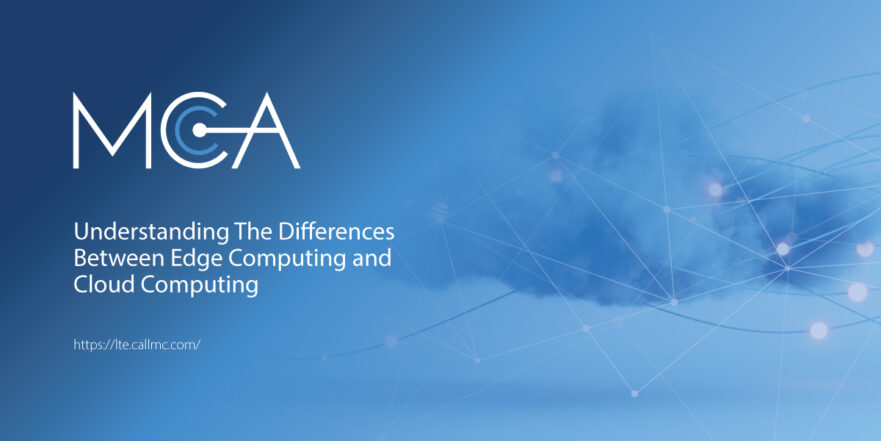Understanding The Differences Between Edge Computing and Cloud Computing
Transforming Business Operations with Innovative TechnologiesAs technology evolves, network managers increasingly focus on understanding the revolutionary impact of edge and cloud computing. The distinct capabilities of these technologies are not just changing data processing and storage but also revolutionizing the way we think about efficiency and performance.
The Edge and Cloud Computing Relationship
At the heart of modern data management, edge and cloud computing provide solutions for varying deployment needs. Both technologies are gradually replacing traditional computing infrastructures, such as corporate data centers, which often involve costly hardware and software updates.
Edge computing refers to data processing at or near the source of data generation, such as IoT devices, sensors, and local servers. On the other hand, cloud computing offers centralized data storage and processing capabilities through remote servers that provide immense scalability and flexibility.
While these two architectures serve different purposes, their synergy offers immense value. They maximize performance by reducing latency (edge computing) while offering broad-scale analysis and long-term data storage (cloud computing). For example, edge computing handles real-time data processing for immediate needs, while cloud computing performs in-depth data analysis for long-term strategic planning.
Key Differences Between Edge and Cloud Computing
Data Processing Location
A fundamental difference between edge and cloud computing is where the data is processed.
Cloud computing processes data in centralized data centers, often far from where it is generated. This makes cloud computing ideal for applications that don't require immediate processing and can handle large datasets from multiple sources.
Edge computing processes data locally or close to the data source. By keeping data processing closer to where it is generated, such as on local devices or nearby servers, edge computing reduces the need for data to be sent to a central data center, resulting in faster response times.
For example, autonomous vehicles rely on edge computing for real-time decision-making, while cloud computing stores and analyzes broader data sets to improve vehicle safety and performance in the future.
Latency and Responsiveness
Latency is a critical factor when comparing edge and cloud computing.
Edge computing significantly reduces latency because data doesn't need to travel to a distant server. Instead, it is processed locally, making it ideal for applications like emergency response systems or industrial machinery control, where real-time processing is essential.
Cloud computing, while scalable, introduces higher latency as data must travel between the end-user and a remote server. Cloud computing remains a cost-effective and efficient solution for applications where split-second decisions aren't necessary, such as large-scale data analysis or customer relationship management.
Data Privacy and Security
When it comes to security, edge and cloud computing, offer different strengths.
Edge computing allows data to be processed locally, reducing exposure to external networks and enhancing privacy. This makes it a preferred solution for industries like healthcare or finance, where data sensitivity is high.
Cloud computing, however, has advanced significantly in terms of security. With investments in robust encryption and multi-layered security protocols, cloud service providers can offer superior security measures that are often more advanced than those available at the edge.
Core Functionality
Each technology serves a distinct core function.
Edge computing primarily focuses on immediate, real-time data processing near the source. This is crucial for industries like manufacturing, where edge devices monitor and control production lines with minimal delay.
Cloud computing, by contrast, excels at aggregating and analyzing data from across an entire network. It’s ideal for businesses that need comprehensive insights or need to store vast amounts of data over time. Cloud computing platforms are essential for advanced technologies like AI and big data analytics.
Connectivity Dependency
Edge computing operates effectively even in environments where network connectivity is unreliable or intermittent. This is because data is processed locally, allowing operations to continue without needing a constant connection to a central server.
Cloud computing, on the other hand, requires consistent and stable internet connectivity for optimal performance. Without access to the cloud, businesses may face operational disruptions.

Core Similarities Between Edge and Cloud Computing
Despite their differences, edge, and cloud computing share several key similarities that make them complementary technologies.
Scalability and Flexibility
Both edge and cloud computing offer scalable solutions, though in different ways.
Cloud computing scales by increasing the amount of data that can be stored and processed, making it suitable for global applications with extensive data needs.
Edge computing scales by adding more edge nodes, allowing for improved responsiveness and performance in localized environments. This makes it ideal for use cases where real-time processing is critical.
For example, smart cities benefit from edge computing's ability to process traffic data in real-time to manage congestion. Simultaneously, cloud computing handles broader-scale data analysis, providing insights to improve overall traffic management strategies.
Cost-Effectiveness
Both technologies contribute to cost savings, albeit in different ways.
Cloud computing helps businesses reduce capital expenditures by utilizing shared resources and infrastructure. This mainly benefits startups and small businesses that need scalability without large initial investments.
Edge computing reduces bandwidth costs by minimizing the amount of data that needs to be sent to central servers for processing. Additionally, edge computing enhances security and privacy, which can help avoid the high costs associated with data breaches.
For example, retailers use edge computing for real-time store inventory tracking, while cloud computing manages analytics across the entire supply chain.
Enhanced Data Management
Edge and cloud computing both offer significant improvements in data management.
Cloud computing centralizes data storage and processing, providing powerful resources for long-term analysis and compute-intensive tasks.
Edge computing, by contrast, processes data closer to where it is generated, ensuring fast, local responses. This is particularly beneficial in environments like healthcare, where edge devices monitor patient vitals in real-time, while cloud systems store and analyze long-term health trends.
The Future of Edge and Cloud Computing: A Hybrid Approach
As technology evolves, the future of data processing lies in the integration of edge-to-cloud architectures. This hybrid model blends the strengths of edge and cloud computing, creating a more efficient, responsive, and intelligent system.
In this model, data is processed initially at the edge for real-time insights, while the cloud handles deeper analysis and long-term storage. For example, Digi’s Edge Computing Solutions combines edge processing with cloud capabilities to provide comprehensive management and monitoring across industries.
A hybrid cloud edge computing model ensures that businesses can scale their operations efficiently, reduce latency, and improve decision-making processes by leveraging real-time data at the edge and extensive analytics in the cloud.
Maximizing Efficiency with Edge and Cloud Computing
The discussion around edge computing and cloud computing isn’t about which technology is better but rather how they complement each other. Businesses can optimize data processing, improve performance, and drive innovation by understanding their strengths and integrating them both into a cohesive strategy.
Whether you prioritize real-time data processing at the edge or the scalability of cloud computing, both technologies will continue to shape the future of digital transformation.
Digi’s Edge Computing Solutions and Cloud Services
The debate surrounding edge computing vs. cloud computing illustrates a landscape rich with technological advancements tailored to meet specific needs. Digi offers multiple solutions in this space, including:
- Digi Remote Manager®: A cloud-based management solution providing secure visibility and control across deployed devices.
- Digi ConnectCore® Cloud Services: Value-added services supporting OEMs in creating connected devices with remote capabilities.
- Digi X-ON® Cloud: A scalable management platform for edge-to-cloud solutions based on the LoRaWAN® standard.
- Digi Axess: A unified platform offering monitoring and control capabilities for industrial automation solutions.
About MCA and Our CNS Team
MCA is one of the largest and most trusted integrators in the United States, offering world-class voice, data, and security solutions that enhance the quality, safety, and productivity of customers, operations, and lives. More than 65,000 customers trust MCA to provide carefully researched solutions for a safe, secure, and more efficient workplace.
Our Cellular Networking Solutions (CNS) team (formerly known as USAT) is made up of certified experts in designing and deploying fixed and mobile wireless data connectivity solutions for public and private enterprises nationwide - complete with implementation, training, proof of concept (POC), system auditing, and on-site RF surveying services with optional engineering maintenance contracts.
Our extensive Digi International catalog of world-class routers, antennas, and software designed for remote monitoring and management in even the harshest environments allows us to deliver a full suite of reliable technologies capped with a service-first approach.
Share this Post













